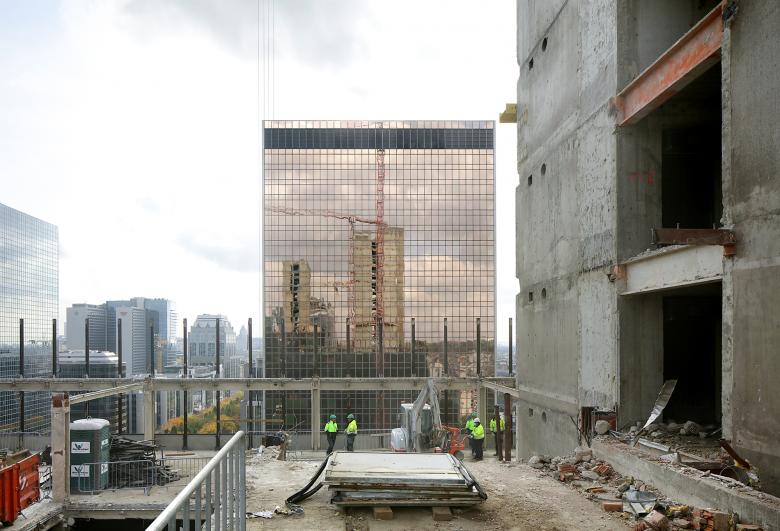‘Soft Power – The Brussels Way of Making the City’ at S AM
Learning from Brussels
With the exhibition Soft Power - Making Cities the Brussels Way, on view at Basel's Swiss Architecture Museum (S AM) until March 16, 2025, S AM declares Belgium's architectural culture to be a role model. But what does Brussels have over Switzerland?
Many architects in Switzerland greatly appreciate the work of their Belgian colleagues. It is no coincidence that ETH Zurich has awarded several professorships to designers from the Western European country in recent years. Now the Swiss Architecture Museum (S AM) is highlighting how pioneering architecture is being created in Belgium's capital with Soft Power - Making Cities the Brussels Way. As is often the case when the museum team looks abroad, it is all about “learning from.” So what can the Swiss — and potentially others — learn from Belgian architectural culture?
The Bouwmeester Maître Architecte makes a decisive contribution to the high quality of architecture in Brussels: Kristiaan Borret, with his team, advises the city and private clients, organizes competitions for them, and awards prizes. For construction projects of over 5,000 square meters (53,820 square feet), collaboration with him is mandatory, otherwise the authorities will not issue a building permit. At the same time, the Bouwmeester's advice does not have to be followed, as he is not a political official. It seems to be precisely this role of neutral expert that enables Borret to steer urban development. His most important tool is competitions: to date, he and his team have held over 400, and they have often produced particularly creative, forward-looking designs.
The S AM curators are particularly interested in these “open calls” in light of the current discussion about the competition system in Germany. While open competitions in Switzerland encourage young architects in particular to exploit themselves (invited procedures with fees are only open to established architects), things are fairer in Brussels. In the first round of applications, in which everyone is allowed to take part, three to five offices are selected on the basis of a letter of motivation, their experience, and expertise — this expressly does not mean that they have to have already designed many buildings of the same size, as is the case in Germany, for example. In the second phase, they work on a concrete design and receive a fee.
The results that can be seen in Soft Power speak for the increased use of this format in Switzerland. After the work of the Bouwmeester is presented in the first room, the two-part enfilade of the S AM is filled with fifteen projects from the last ten years that are exemplary of the architectural scene in Brussels. Kristiaan Borret's team was a consultant, mediator, or organized the competition for all of the projects; museum visitors can find out more in an audio guide that they can access via QR codes. Sorted according to five themes, the works are presented with large models, plans, descriptive texts, and, in some cases, material samples.
The many unusual approaches are particularly striking when exploring the two galleries. In its Manufakture project, Büro Baukunst stacks a swimming pool above parking decks and production rooms in which meat is processed. 51N4E, l'AUC, and Jaspers-Eyers have inserted a new high-rise slice between the towers of the Brussels World Trade Center; the resulting hybrid accommodates apartments and hotel rooms in the existing building and two-story offices in the new building, and there are leisure facilities and stores in the base, which should ensure a better connection with the neighborhood. Together with the reuse specialists from Rotor, the Quest office has converted the ensemble of a former printing works for the Zinneke cultural organization. The project was designed by the client and architects in a co-creative process and built with used parts.
In addition, some of the buildings in the last room of the show can be seen in moving stills by architectural photographer Maxime Delvaux. This installation, accompanied by a soundscape, rounds off Soft Power, showing that Brussels is not a homogeneous, picturesque city, but rather thrives on fractures and diversity. The successful exhibition design was the brainchild of Asli Çiçek. The architecture professor won a competition, which was appropriately held along the lines of the Brussels "Open Calls": 61 applications were received in the first phase and then three teams were invited to submit proposals.
“Do we still need an exhibition on Belgian architecture?”, some visitors may ask themselves in advance. After all, projects from Belgium have been discussed many times recently outside its borders, and the work of Bouwmeester Maître Architecte was the subject of the Normcore Arch+ issue years ago. However, the S AM team has succeeded very well in linking its examination of Brussels' architectural culture with the current Swiss discourse. This applies not only to the topic of competitions, but also to the buildings and designs on display: the unorthodox mix of functions, the participatory processes, and the reuse projects in particular are valuable inputs for the Swiss discourse.



